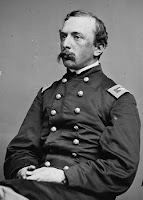
A Democratic Congressman from South Carolina, Preston Smith Brooks died January 27th 1857.
Preston Smith Brooks was born August 5th 1819 in Roseland, Edgefield, South Carolina. He was the son of Whitfield and Mary Parsons [Carroll] Brooks. He attended South Carolina College [now known as the University of South Carolina]. He may or may not have graduated in 1839, if he didn’t it was do to some issues of threatening with a firearm. Brooks became a lawyer in 1845, and served with the Palmetto Regiment during the Mexican American War.
He had a duel with Louis T Wigfall and was shot in the hip which caused him need to use a cane. Brooks became a member of the South Carolina House of Representatives in 1844. In 1853 he was elected to the United States Congress. It was while serving in Congress that Brooks beat United States Senator Charles Sumner an anti-slavery advocate, in the United States Senate chambers with his walking cane. The beating was caused by a speech given by Sumner a few day before in which Sumner had spoke against a member of Brooks’ family. Brooks is quoted as saying "Mr. Sumner, I have read your speech twice over carefully. It is a libel on South Carolina, and Mr. Butler, who is a relative of mine." Sumner started to stand up and Brooks him in the head with his cane, which had a gold head. Sumner couldn’t get away as he was trapped by his desk which was bolted to the floor. Brooks continued to beat Sumner until his cane broke and Sumner was unconscious.
Brooks survived a vote to remove him from his House seat, but he resigned anyway. His constituent returned him the Congress thinking him a hero. Brooks stayed in the office until he died January 27th 1857 in Washington DC from the croup. He is buried in Willow Brook cemetery in Edgefield, South Carolina.
 The United States mint in New Orleans was taken over January 31st 1861 by the state of Louisiana.
The United States mint in New Orleans was taken over January 31st 1861 by the state of Louisiana.




















